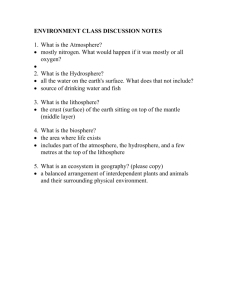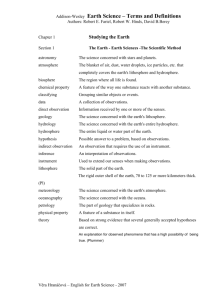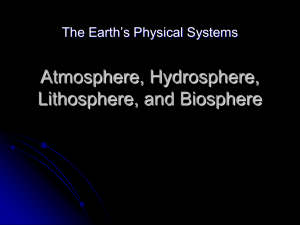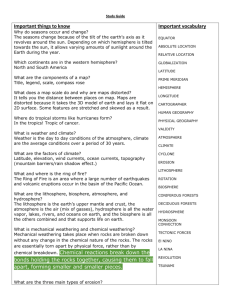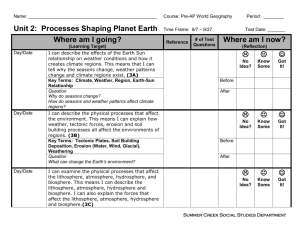our environment
advertisement
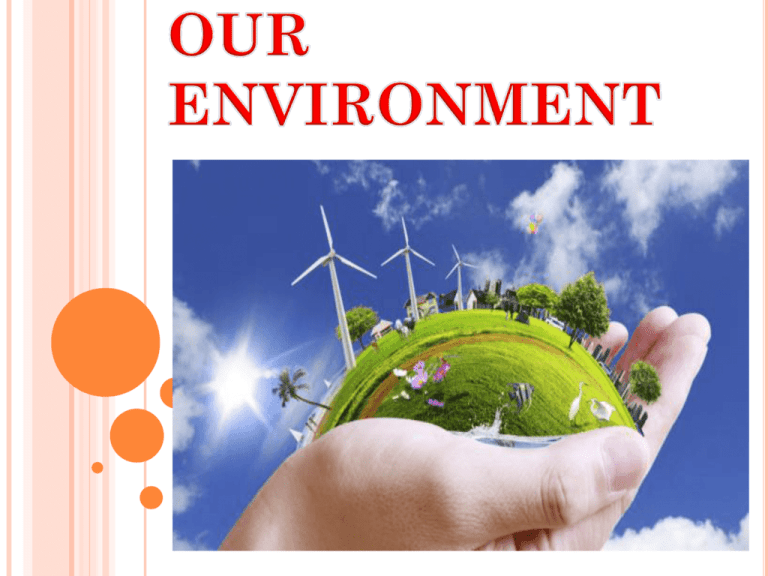
Environment means the surroundings. Land, water, air, plants, animals, solid wastes and other things that are surrounding us constitute our environment. Man and environment are closely intertwined with each other, to maintain a balance or equilibrium in nature. Different groups of people working in different areas express it in various ways. When physical scientists talk about environment they generally refer to the physical environment that comprises the three inter locking systems the Atmosphere, the Hydrosphere and the Lithosphere. Biologists often refer to biological environment consisting of all living organisms of the Biosphere. Similarly social scientists refer to the social, cultural, economic and organizational environment. Hence environment may be defined as "the sum of all social, cultural, economical, biological, physical and chemical factors surrounding the 'man' to give necessary protection to him." The natural environment consists of the physical environment and the biological environment. The three major components of the physical environment are the atmosphere, the lithosphere and the hydrosphere. The are the a biotic or non living components of the natural environment. The physical and the biological environment undergo changes over time . changes may be distinctive and sudden ( when an earthquake or landslide occurs), gradual and noticeable (population growth), or too slow to be noticed (mountain building). The lithosphere is the outermost, solid surface layer of the Earth. It is also sometimes called the crust. The word lithosphere is derived from the Greek word lithos, which means “stones”. The surface of the Earth is not flat. It is uneven, with different kinds of landforms like mountains, hills, valleys and plateaus. The crust is covered by a thin layer of soil which is of vital importance for life. The lithosphere is that realm of the Earth through which most of the needs of humans are met. The layer of air that surrounds the Earth is called the atmoshphere. The atmosphere is a mixture of gases, dust and water vapour. The word atmosphere is derived from the Greek word atmos, which means ‘vapour’. The gravitational force (the ability of a body to pull or attract everything around towards itself) of the Earth holds atmosphere around it. The atmosphere is useful to humans in different ways. It provides the life-giving gas oxygen. We inhale oxygen and exhale carbon dioxide. It acts as a blanket and keeps the Earth warm by trapping the hear that radiates from the Earth( terrestrial radiation). It protects life from the harmful rays and the scorching heat of the sun. Hydrosphere (derived from the Greek word by dor, meaning water) refers to the water on the Earth. The earth is called the blue planet because 71% of its surface is covered with water and only 29% with land. Water is found as solid ice in glaciers and ice sheets. It is found as liquid water in oceans, rivers, lakes, ponds and underground streams. It is also found as water vapour in the atmosphere . water moves continuously from one form to the other; this movement is called the water cycle. The biosphere is the narrow zone of contact between land(lithosphere),water (hydrosphere) and air (atmosphere),where life forms exist. It is also called the living world or the biological environment. Everything in the biosphere is interconnected and interdependent. Forests provide products like timber, fruits, nuts, resins, lac and medicinal herbs. They also provide a natural habitat for various plants and animals. Forests help moderate atmospheric temperature by absording carbon dioxide and adding moisture to the air through transpiration. Many animals depend on forests and grasslands for their food. Have you ever wondered why there are cone shaped trees and animals with long fur, like the yak, in ladakh, and not in Mumbai or Delhi? Why are camels found in Rajasthan and penguins in Antarctica? This is because plants and animals have their own typical habitats to which they have adapted themselves. They live like a community and they depend on each other and on their immediate physical surroundings. In fact, everything in the natural environment is connected. The natural environment consist of several interconnected ecosystems. An ecosystem is a community of living things and nonliving components that work together. Ecosystem have no particular size. An ecosystem can be as large as a rainforest, or as small as a pond. Grasslands, costal (oceanic) areas, mountains, deserts, lakes- all have their own unique ecosystem. The human-made environment is that which is created when human beings interact with the natural environment. It consists of the built environment, which includes buildings, railway tracks and bridges; and the socio-cultural environment, which includes family, school and college, community, country, religion, music and dance and cinema. Human beings adapt themselves to the natural environment by making modifications in their shelter, food and clothing. They also modify the natural environment to suit their social, biological, economic and cultural needs. People who live in hot, wet coastal areas like karalla or coastal Odessa traditionally eat rice and fish. They also wear cotton clothes which keep them cool, and live in houses with sloping roofs so that rain can run off easily. People who live in the icy reaches of ladakh wear woolen, clothes, and traditionally eat food based on barley and wheat. People who live in places like Punjab and utter Pradesh, which have very cold winters and hot summers, dress and eat according to the season. Food during winter includes items that are energy giving, such as til(sesame), groundnut, jaggery, mustard oil, etc. Human also change their environment to suit their needs. The early humans slept on trees and caves and foraged for their food. With the passage of time, humans started changing the natural environment to their advantage with the help of varied skills and technologies. They started building houses to live in. they discovered minerals and invented machines. The growing population and increasing demand for goods resulted in rapid industrialization and mass production. To satisfy their ever increasing wants, the natural environment is being exploited indiscriminately by humans. This is leading to environmental degradation. Environment degradation is the process by which the environment is increasingly polluted, overexploited and destroyed.

